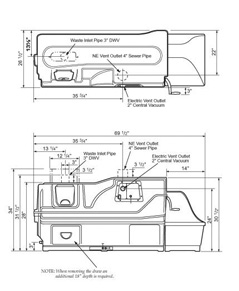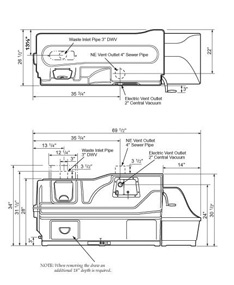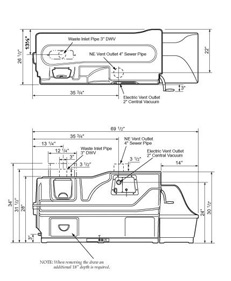Product Description
Sun-Mar CENTRAL FLUSH Composting Toilet Systems
The Centrex 3000 NE utilizes a continuous flow design for very heavy cottage or medium residential use. With a continuous flow system, rotation of the drum moves compost along the larger and longer 3000 series drum, before it drops automatically into the collection housing at the end of the unit. Under normal operating conditions the drum will not have to be turned backwards for emptying.
The Centrex 3000 NE (Non-Electric) is the non-electric version of the Centrex 3000 which is fitted with a 4" vent stack. Installation of a 12 Volt fan is optional, but it is recommended for heavy seasonal, residential use, or where the installation is particularly subject to downdraft, being surrounded by high trees or hills. We also recommend the fan if you need to install a bend in your vent stack.
All Centrex 3000 series units are supplied with a 1" drain hose which should be connected to the 1" drain at the bottom left of the unit. This unit is for use with a Sealand low flush toilet.
How Composting Works
Composting is Nature's Way
Every living organism consumes nutrients and creates waste. To transform waste back to nutrients and complete this cycle, nature uses the processes of decompostition and evaporation.
Sun-Mar toilets are designed not only to harness these natural processes, but to optimize and accelerate them.
Toilet waste is over 90% water content. This can be evaporated and the small amount of remaining material is recycled into a useful fertilizing soil.
Sun-Mar units are economical, quick to install and easy to use and because no chemicals nor septic systems are used, fragile environments can be protected.
A Sun-Mar composting unit is an environmentally healthy choice for recycling human waste.
And there's no smell!
The Sun-Mar system evaporates excess liquid and by continuously pulling air in it ensures no smell escapes from the unit.
ENVIRONMENTAL BENEFITS
By using a Sun-Mar composting toilet you are doing your environment a huge favor.
- You are protecting your lake and ground water from being polluted by pathogens and nutrients
- You are saving huge amounts of water
- You are recycling the nutrients directly back to the plants they came from.




